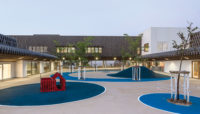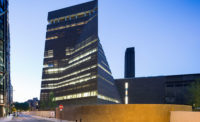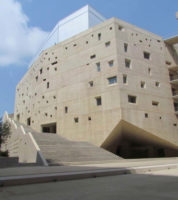Standing atop a skeletal steel observatory tower in a new 280-acre park at Carrières-Sous-Poissy, in the western suburbs of Paris, one gets a panoramic view of the wider environment that shaped both the design of the landscape, by Agence TER, and of the two prominent structures on it—a museum and the viewing platform itself—by architects AWP and HHF. Created from overgrown wasteland, the park, named Parc du Peuple de L’Herbe (Park of the People of the Grass), lies within a tight loop of the River Seine, bordered on one side by water and on the other by a fast-growing residential area. Competition design briefs for both the landscape and buildings asked for economical interventions that could transform the former industrial site into an inviting destination offering diverse scenery and activities.
Additional Content:
Jump to credits & specifications
Agence TER concentrated its most intensive landscape interventions at the margins. An “active strip” of pedestrian routes, cycle paths, and sports pitches blurs the boundary between the city and the park. At the river’s edge, new boardwalks and seating areas increase access to the water, and remodeled banks encourage the growth of riverine vegetation. In between, a lightly remediated “natural area” has been enhanced by the planting of additional trees, shrubs, and small plants, and is crisscrossed by gravel paths that run between patches of arid prairie and flower meadows, small copses, and two large treefringed ponds.
Sited on the active strip and resembling a cluster of interlocking barns, the museum defines the principal entrance to the park. The 42-foot-high observatory sits near the center of the site, providing an orientation point and an incentive to venture deeper into the landscape. The two buildings are the largest of more than a dozen follies that were originally proposed by the architects, including a café, a climbing wall, and a skate ramp. All would be made by using a limited set of low-cost components to create houselike forms, alluding to nearby nondescript suburban dwellings and to the cabins of barges moored on the river. Though the smaller elements were eliminated from the plan because of changing economic and political circumstances, the fundamental ideas survive in the two realized buildings, which use structure both to generate architectural character and to frame views of the landscape beyond.
This approach comes from the diverse preoccupations of Basel-based HHF (RECORD Design Vanguard, December 2010) and Paris-based AWP, which have collaborated regularly since meeting as the designers of their respective national pavilions at the 2007 São Paulo Biennale. The project is “the child of two very different parents,” says HHF partner Simon Frommenwiler. “We start with a structural logic; AWP has a freer, more cinematic way of designing and activating public space. We establish rules and they break them until we reach equilibrium.”
Like the nearby follies, the entry building was originally conceived as a domestically scaled structure, but it tripled in size with the decision to incorporate a museum of insects, and now comprises five pitched-roof sheds, overlapping at irregular angles. The agglomeration FULL VIEW Meandering paths carry visitors between the museum and the observatory (opposite two). The tower (left) is partially timber-clad to direct views to the river and the grand villas on the opposite bank, but also toward housing projects and industrial sites in the other direction, so that the wider context of the park can be understood. of conventional forms is at once strange and familiar. “I’ve always played with the idea of the uncanny,” says AWP partner Alessandra Cianchetta. “Doing something uncommon with the common is a way of getting people to accept something that is unusual.” Further ambiguity is lent by enigmatic, scaleless facades, whose wood cladding extends over the roofs, walls, and windows as a slatted brise-soleil. Though safely out of the flood plain, the building cantilevers off a concrete base and seems to float like the river barges.
Inside, there are working labs and offices for the entomological institute, alongside a flowing sequence of lofty exhibition halls that join together where the building modules intersect. It is here that the spatial effects of the structural concept is most apparent, as the corners of each portal frame protrude into adjacent rooms like stands of sturdy trees or giant wooden spiders’ legs. Daylight filters softly through translucent polycarbonate siding and the slatted timber shades over the giant windows, which by night emit an otherworldly orange glow.
Whereas the museum conjoins archetypal pitched-roof house forms horizontally, the observatory stacks four of them vertically, outlined with diagrammatic clarity in white-painted steel. Maintaining their legibility proved challenging, but engineer Schnetzer Puskas developed an elegant solution in which the staircase stiffens the frame so that cross bracing is not required. And, since the structure is classified as a work of art, it could be constructed without an elevator. Again, structural rigor is yoked to a subversive search for the “uncanny”; one house form, resting on the inclined roof below, is pitched at an alarming angle, “as though the structure couldn’t work” and the stack is collapsing, says Cianchetta. (The impression of instability is not merely perceptual: at the top of the tower there is a pronounced wobble, triggered by footsteps or a light breeze.)
The hybrid character of both structures—which fuse the pragmatic and the playful, the strange and the familiar—makes sensitive connections to a landscape that is itself hybrid, responding to the city and the river, and blending controlled cultivation and wild nature. Shaped by the environment, the buildings and the landscape design add interpretive layers to the once-inhospitable terrain, forging a strong sense of place amid so much space.
CreditsArchitects: AWP + HHF Team AWP Team HHF
Landscape: Agence TER
Engineers: Grontmij, EVP, Schnetzer Puskas Ingenieure
|
SpecificationsTimber walls and roofs Nature Bois Interior glass cladding Saint-Gobain Interior greenhouse, windows, and skylights Wicona Resin floor Him Floor Polycarbonate Akyver |












